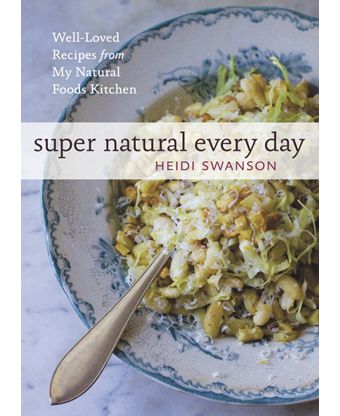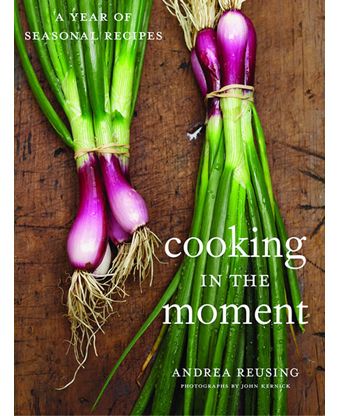As I write this, I am sitting at a table looking at my collection of cookbooks. Most are on the bookshelves but there are a number cluttering up table, desk, and just about every available surface, with a dangerous pile amassing on the floor. At the last count there were just under 4,000 -- not much room for more, you might think. You'd be wrong. The collector knows no nonchalance: a new title is always a fresh excitement. So when my parcel with its brace of books arrived from the Piglet, reader, it was me who squealed.
In truth, to call myself a collector is to be unnecessarily high-falutin'. What I really am is a consumer — a passionate, greedy, grateful consumer, happy to wallow in whatever occasions of pleasure the opportunity provides. And let me tell you, Andrea Reusing's Cooking in the Moment and Heidi Swanson's Super Natural Every Day provide occasions of pleasure a-plenty. The only irksome thing here is that I must judge between them. Why should I complain? It's what I agreed to, after all. But the idea of choosing between two books in theory, and the act of doing so in practice are different things. A book is never just an object to be marked out of ten: it has a personality, a voice, it is a thing unto itself. Or it is, if it's done well. On the one hand, I am glad that both these books are indeed done well. On the other, it doesn't make my job any easier...I have read these books, cooked from these books, lived with these books, and now I feel distinctly uncomfortable judging them. It would be rather like inviting folks for dinner and then sending them home with grades for their conversation, entertainment value, and appearance.
Let me, rather, introduce them to you. And I will do so in alphabetical order of author. So, we start with Cooking in the Moment, a title I loved, with its heady connotations of spontaneity. All of us who cook can't help but warm to the romantic notion of seasonal local shopping, a sensual stroll, basket in hand, from market stall to market stall, foraging for today's fabulous fresh produce. Unfortunately, most of us don't get to live or shop like that, but we can dream, and from gray London a celebration of earthy North Carolina fare is as good a dream as any. But for this fantasy to be worth having, the recipes have to apply in the real sphere too. I have to admit I sampled out of season, cooking carrot soup with toasted curry and pistachios and crab and garlic fried rice from Spring, the grilled zucchini with mint, chile oil, and toasted pine nuts from Summer, the hard-cider braised pork shoulder from Fall, no-poach poached chicken and roasted spareribs with crushed fennel and red chiles from Winter. And I salivated over an awful lot more. My criteria for choosing what to cook were straightforward. I let greed speak in the first instance, and laziness in the second. That's to say, not only did I have to want to eat the recipe being outlined in front of me, I had to know it would be feasible without going to six different shops to source the ingredients. I'm afraid that wasn't always easy. This wasn't just about seasonal differences in availability, but because there is a modish Asian sensibility at play here, too, which while it might make for fabulous food, it doesn't always make for accessible ingredients lists.
But to the success stories: the carrot soup with toasted curry was a knockout, and that I regard as a huge achievement. It's easy enough to make a stir with some big deal showstopper, but to make a carrot soup exceptional is much more impressive. I was grateful that the recipe pointedly uses water rather than stock; Reusing calls this "useful laziness" and I was as grateful for the term she coined. The soup itself keeps the bright taste of the carrots, adding for ballast, onion, cayenne, dry white wine, and some home made curry powder that I cannot now be parted with. Making your own curry powder is one of those things that just sounds harder to do than it is. You just toast some coriander seeds, cumin seeds, black mustard seeds, fenugreek seeds (at last: a reason to take them from my spice rack!), black peppercorns, dried red chiles (I couldn't find the de Arbol ones specified) and ground turmeric. One batch of this provides very much more than you'll need for the soup, but that is a Good Thing. I keep mine in a jar and have used it as often as possible since: I made a lovely crab cocktail with it only the other day, and sprinkled it lavishly into a spinach omelette for my supper last night. This, to me, is the sign of a successful recipe. And the carrot soup itself was comforting but still sprightly warm and when, in the spirit of enquiry, I tasted it chilled the day after, I felt it would make an elegant dinner party starter.
As a cookbook writer myself, I feel somewhat abashed to make comments about a recipe when I haven't followed the recipe to the letter, but as I don't have a charcoal grill, I am afraid I did have to grill my zucchini on a ridged griddle. Luckily, they work just fine: you cut them into long tongues, brush them with chile oil, and then grill them till they are scorched in parts then arrange them on a platter sprinkled with toasted pine nuts, shaved parmesan, and fresh mint. I have made a version of this for years, only I add a spritz of lemon juice and use sharp salty feta in the place of the parmesan (or Vella Dry Jack) specified here. But I am always happy to try a fresh twist or new version: that is cooking, after all.
The real triumph for me, here, were the spareribs with crushed fennel and red chiles. This was outrageously simple — you just rub a little oil onto some pork spareribs, crush some dried chiles and fennel seeds in a coffee grinder (or somesuch) and rub that on, too, with a little salt. After 15 minutes in a blisteringly hot oven, you give them just over an hour at 375 and when ready these ribs are gorgeously spicy, meltingly tender, and just about the best ribs ever. And what's more, easy to eat: you don't need to provide wet wipes as you serve them. People are still talking about these ribs in my house, and I am still thinking of them.
Less successful for me were the hard-cider braised pork shoulder, the no-poach poached chicken and the crab and garlic fried rice. Let me qualify that: the pork was wonderfully succulent, and I don't have complaints about it, but nor do I feel I will cook it again. Or not quite in that way. I'd rather make it less stewy and give it a bit more burnish. The no-poach poached chicken is exactly what it says it is . You flavor some water, add a chicken, bring to the boil, simmer for 5 minutes then let the chicken cool in the water. When everything's cold, the chicken — in theory — will be cooked. Well, it was cooked, but only just, and I couldn't persuade anyone to eat the dark meat, as the texture and pinky look were unappealing. The white meat was perfect. And while it's true that it makes for the most wonderful juicy meat for a chicken salad, I can't help feeling that a poached chicken does too, and that way you can eat the chicken hot, and the water it's cooked in is an instant soup. It's perhaps unfair to quibble on the first point, as I knew that the chicken was only to be eaten cold when I read the recipe, and of course you could make a plausible energy-saving argument here.
The more I read the book, the more I find Reusing's palate resonated with me, and so the disappointing blandness of the crab and garlic fried rice (when the title alone gets you in the mood for a bit of punch) was mystifying. There is indeed a lot of garlic — 2 tablespoons — but it got lost in the 4 cups of rice and 5 egg yolks. I am a home cook rather than a chef, so I'm always disinclined to use large numbers of egg yolks rather than fewer whole eggs, but a recipe like this can bear some fiddling and twiddling, and left to my own devices (for a re-trial) I added some chopped scallions and ginger along with the garlic and used 2 whole eggs in place of the 5 yolks stipulated. It was less refined, to be sure — the yolks-only approach makes for a soft and creamy binding — but earns more of a place in my own kitchen. For that, I'm grateful.
There's plenty else I liked about this book, too: the colors are beautiful, from the pink shallots on the cover to the saturated mossy green of the endpapers and John Kernick's prettily charming photographs. I was not convinced that the layout was always in proper service of them, though.
Now, to Super Natural Every Day, a book that had my tummy rumbling after the first flick-through. But as with Cooking in the Moment, you are expected to do a certain amount of dedicated shopping. Sometimes, I just couldn't find whatever precise ingredient was required, but — a good sign — this didn't interfere with my enjoyment of the recipes.
I suppose we tend to gravitate towards those recipes that most suit our own style of cooking, and I hit the baking first. Whereas I take it for granted that when I cook, I will want to play fast and loose with the seasoning and so on, when I bake, I need to know that the recipe in front of me can be taken on face value. Yes, I might want to rejig a little after according to my own taste, but a baking recipe must work, unaltered, off the bat. So let me start this review with two words: Yogurt Biscuits. And let me add a third: Heavenly. Made with spelt flour, butter, and Greek-style yogurt they are celestially light, flaky, and almost derange-makingly gorgeous. I have long been a fan of spelt flour, but even I couldn't imagine it could make for anything this light.
This is as good a place as any to say that if I had any doubts about the book on initial reading, it was because I always fear a certain smuggery, and words like "my natural kitchen" set off the alarm bells. But I am tolerant to the point of permissiveness, and if something tastes divine, I don't care how good I'm told it is for me.
Another case in point are the Multigrain Pancakes. These are light and fluffy and altogether entirely seductive. And I say that as someone who wasn't entirely happy to be sent out (without complete success) for whole wheat pastry flour, oat flour, and rye flour. Well, the rye flour was easy enough, but wholewheat pastry flour entirely eluded me and oat flour proved irksome; I found an online source only and I wanted to make these now. I substituted something labelled organic spelt white flour for the whole wheat pastry flour and after much research on the internet, whizzed some organic porridge oats in the processor to make my own flour. I resent not one of the minutes spent tracking down the wherewithal to make these as they were truly a triumph. The flours were sweet and nutty and ably helped by the generous amount of melted butter that goes into the batter. I tell you that before you come over too virtuously enthusiastic. What also helped was the really peppy Blackberry-Maple Compote that Swanson suggests you serve alongside. I customarily make a blueberry maple compote/sauce and let me say, I was won over by this gingery blackberry version.
For the lazy baker, the Macaroon Tart is to be urgently recommended. The crust is made by stirring together some flour (again, I couldn't find the white whole wheat flour specified so used my spelt white flour) with some unsweetened finely shredded coconut, natural cane sugar, and melted butter, and you simply turn this mixture into an 8" x 11" inch tart pan (or equivalent) and press it in. It could scarcely get any easier. The fruit topping consists of some blackberries, more shredded coconut, sugar, and four egg whites. It strikes me now that had I made this the same day as Reusing's fried rice, I could have used yolks for the rice and the whites for this. As it is, I had a very rich plate of scrambled eggs for supper. This tart was a major success in the Lawson household. I remade it with a few more blackberries as I wanted the sweet-sharp balance to be slightly tweaked toward the sharp, but that is not a criticism. This is a fabulously easy recipe that rewards way beyond the effort involved.
From the savoury kitchen, the Chickpea Wraps lured. Think whole wheat lavash (bread as thin as a lace tablecloth) wrapped around an unhummussy hummus — chick peas roughly processed and mixed with chopped red onion and celery, dill, yogurt and Dijon mustard — and some mixed salady greens. Some of the yogurt and mustard makes for a flavorsome spread to go under the greens and helps stick them to the lavash; I want to eat it dolloped alongside grilled lamb cutlets, too. This was not a recipe with a capital R, but it made for a lovely lunch that even resident teenagers enjoyed.
Now for a recipe that caused a certain amount of controversy in casa mia: to whit, the Tortellini Salad. I was drawn to try this as the idea of cold, cooked tortellini in a salad (admittedly gussied up with broccolini, asparagus spears, pine nuts and alfalfa) sounded just compellingly awful. I was not entirely wrong. To me, it tasted as if it belonged on an upmarket cruise ship's buffet table, still alluring but in a naff kind of a way; to everyone else in my household it was manna from heaven.
Cooking from both these books was a pleasure; judging them against one another is uncomfortable. To ease that, I premise these remarks by saying that what follows is not an objective judgement but a fair record of my own tastes and inclinations. As it is, I am very happy to have both books in my library. The old test that if a cookbook provides just one recipe you add to your repertoire it's been worth the cover cost holds true, and I have acquired more than one from each. Cooking in the Moment is a charming and inspirational volume and I can say nothing bad about a book that's given me that soup and those ribs. But my heart has been won by Heidi Swanson: I love her prose, I love her photos, and, for all that I don't see that one flour is any less of a processed food really than another or that tortellini in a salad is "natural" in any way, I just want to cook these recipes. So, I don't buy the schtick, but I want the book. It truly is the home cook's treat.
The Piglet / 2012 / First Round, 2012
VS
Judged by: Nigella Lawson

Nigella Lawson, food enthusiast, television personality, and journalist, is the bestselling author of Nigella Kitchen, Nigella Express, Nigella Fresh, Nigella Christmas, Nigella Bites, Feast, How to Be a Domestic Goddess (for which she won the British Author of the Year Award), and How to Eat, which together have sold more than 6 million copies worldwide. These books, along with her groundbreaking iPhone App and her television shows on Food Network, E! Entertainment Television, and Style, have made hers a household name around the world. Nigella's most recent Food Network series is Nigella Kitchen. Nigella lives in London with her family.


29 Comments
Second, I have both these books and have made nary a recipe from either. But I will be making those ribs on Super Bowl Sunday and trying Yogurt Biscuits before then.
You are lucky to have such a gracious reviewer as Nigella. You are even more lucky that Melissa Hamilton and Christopher Hirsheimer would even consider reviewing for your after the horrible comments made about the splendid, actually incomparable, Canal House Cooking, when it was being judged in The Piglet.
I loved reading about both books. Fantastic appraisal and well done.